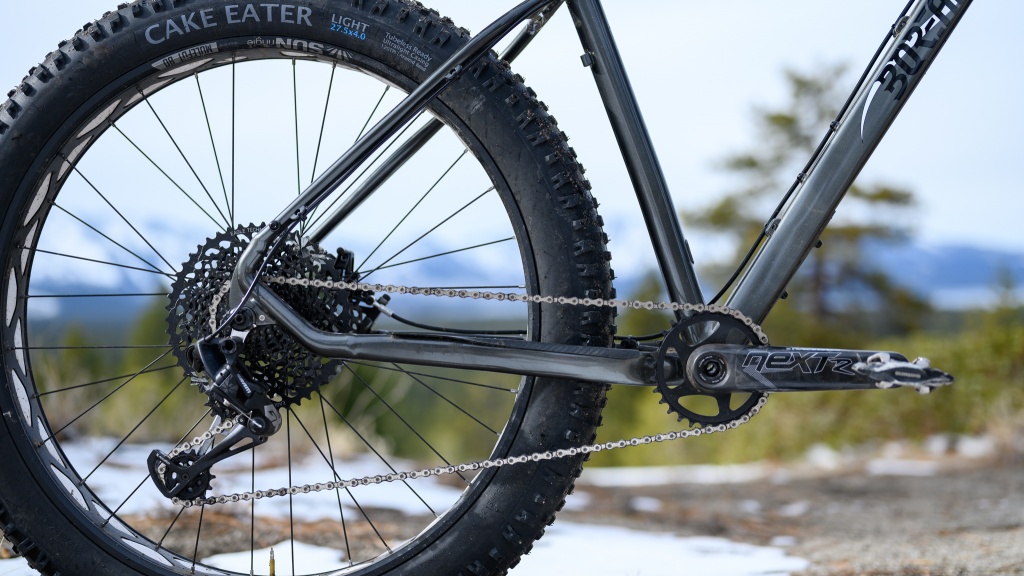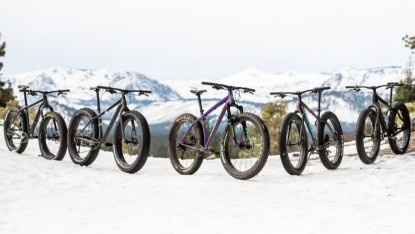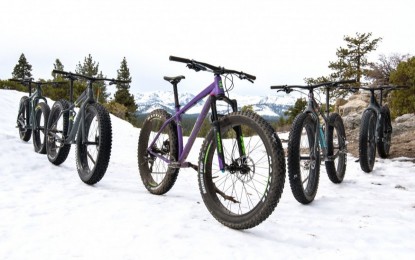Borealis Telluride GX Eagle Review
Our Verdict
Our Analysis and Test Results
Borealis makes fat bikes exclusively, and the Telluride is one of a few models in their line. The Colorado-based brand takes fat biking seriously, and they even put on the Fat Bike World Championships annually in Crested Butte, Colorado. It stands to reason that they know a thing or two about fat biking, so we thought it would be good to get one of their models in our review. We tested a model with a very nice build that includes a GX Eagle drivetrain and a Manitou Mastodon fork. Our testers felt that the Telluride was, in fact, a great fat bike, but also that it was held back a bit by its quirky geometry.
Performance Comparison
Downhill Performance
The Telluride performed relatively well on the descents, but our testers felt it was hamstrung a little by its somewhat funky geometry numbers. That said, most riders who are riding this bike in cold and snowy environments on mellow terrain will likely enjoy the comfort it provides and rarely reach its limits. Riders who frequent steeper trails or who may push the limits of speed may find it to feel a bit odd. That said, the higher-end build we tested with a suspension fork performed very well and enhanced this bike's downhill performance.
When you look at the geometry of the Telluride on paper, it's pretty interesting. Our size large test bike has a long 1205mm wheelbase, long 475mm chainstays, an average 68.5-degree head tube angle, and a short 438mm reach. Both the long wheelbase and the very long chainstays should theoretically give this bike excellent stability at speed, and the head tube angle is similar to most of the other fat bikes we tested. Despite having the longest wheelbase in our test selection, the Telluride has one of the shortest reach measurements and the tallest front end. It's not that the reach is outlandishly short or anything, but when combined with the very tall front end of the bike, it resulted in a very upright body position. This position is quite comfortable and felt good for cruising around at moderate speeds and terrain. In steeper terrain or at higher rates of speed, however, the very high front end and short-reach made it challenging to get in an aggressive body position, and the bike felt unstable and even twitchy despite its overall length. Of course, pointing it down steep terrain and riding crazy fast isn't what this bike is intended for, but it is notable nonetheless.
Assuming you don't intend to push the envelope of speed and terrain, the Telluride is a comfortable faithful companion. The simple fact that the Telluride's build came with a Manitou Mastodon Pro fork with 120mm of travel made this bike feel better over choppy snow and rough surfaces. When riding on snowmobile tracks, hiker packed snow, or rough trails, this fork does wonders to take the edge off, especially when compared to the rigid forks found on other models. The SRAM Guide RS brakes were another highlight with a great lever feel and plenty of stopping power for fat biking speeds. The 4-inch wide Terrene Cake Eater tires had plenty of grip on firm snow, and they performed better on dirt and mixed conditions than the wider tires found on most of the other models we tested. The carbon handlebar and seatpost were a nice touch, although testers would have preferred a bar wider than 740mm, and a dropper post would be the first upgrade we'd make to improve this bike's downhill performance dramatically.
Uphill Performance
The Telluride performs relatively well on the climbs. At 31 lbs and 12 oz, it's reasonably lightweight for a fat bike, and it has nice components that simply work well. Again, the geometry defines the uphill performance of this bike, most notably the high front end, and gives it a very unaggressive feel that is best suited cruising on mellower terrain and pitches.
Testers found the Telluride to be relatively comfortable on the climbs, though the seated position is quite upright and non-aggressive. Sitting and spinning felt the best on this bike, attacking hills with out of the saddle efforts felt a bit awkward. The short reach and tall front end combine to make for a pretty compact cockpit where one tester said he felt “submerged” in it. As mentioned before, the front end of this bike is quite tall, even with the stem slammed, testers found it difficult to get their weight far enough forward for scrambling up steeper sections of trail. Testers also found the bottom bracket to feel quite low, and that extra care needed to be taken to avoid pedal strikes when navigating around obstacles.
The SRAM GX Eagle drivetrain performed flawlessly during testing and provided adequate range for our testers. The Terrene Cake Eater tires were reasonably fast-rolling, and they provided excellent traction on firmer snow and dirt surfaces. The 4-inch width is relatively versatile, testers noted, however, that they didn't give the same level of floatation or traction on slippery snow surfaces as some of the wider tires on other bikes in this review.
Versatility
The Telluride with the GX build we tested is a relatively versatile fat bike. Because it comes with a suspension fork and narrower 4-inch tires, it performs better on dirt than many of the rigid models with wider tires. Riders looking for a comfortable and easy-going fat bike for riding mellow terrain year-round may really enjoy this bike. While it doesn't have a wealth of bottle cage or other accessory mounts, it does have rear rack mounts, and the large open front triangle can easily fit frame bags that attach with velcro. We feel this bike could make a great bike packing rig for snow, desert, and mountain trail riding.
Build
The Telluride we tested came with the GX Eagle build with the Mastodon fork upgrade. The bike is built around Borealis' 6000-series aluminum frame with a Manitou Mastodon EXT Pro fork with 120mm of travel. This is one of only two models we've tested that features front suspension, and it truly makes this bike far more comfortable to ride on rough surfaces than its rigid competition. The fork has a variety of adjustments including an air spring, rebound, and compression to dial it in to your liking. The frame has two bottle cage mounts, external cable routing, and can accommodate an internally routed dropper post.
The GX Eagle build we tested comes with, not surprisingly, a SRAM GX Eagle drivetrain. This includes the shifter, derailleur, and cassette. Borealis has spec'd Race Face Next R carbon cranks, which come standard on all Telluride builds to achieve a narrower Q-factor. A 30-tooth front chainring is paired with the 11-50-tooth 12-speed cassette. The braking duties have been tasked to a set of SRAM Guide RS brakes. Thes brakes have great levers and plenty of power to handle the low to moderate speed typical of fat biking.
The cockpit consists mostly of Borealis branded components. It came with a Borealis stem, a 740mm wide Borealis carbon handlebar, a Borealis rigid carbon seatpost, and a relatively comfortable Borealis saddle. A comfortable set of lock-on Ergon GA30 grips rounds out the cockpit setup.
Like most of the other fat bikes we've tested, the Telluride rolls on SunRingle Mulefut rims. The 80mm wide rims are laced to a set of Borealis hubs with 177mm rear axle spacing. A matching pair of tubeless-ready Terrene Cake Eater 4.0" tires provide adequate girth and traction for most snow riding while also rolling fast and performing well on dirt and mixed conditions.
Geometry
We've touched on the geometry of the Telluride and its relation to performance briefly in the sections above. While many of this bike's numbers are in line with the competition, it has a few quirks that define its performance. We measured our size large test bike and found that it had a 1205mm wheelbase, the longest of all the models we've tested. Part of the reason it has such a long wheelbase is that it has very long 475mm chainstays. The effective top tube measured 642mm with a 438mm reach. The bottom bracket was 314mm off the ground. The head tube angle measured 68.5-degrees with a 73-degree seat tube angle. The strangest aspect of this bike's geometry for our testers was the especially tall front end. We measured from the ground to the top of the head tube and found it to be 995mm high, 30-40mm taller than most of the other models tested.
Value
The Telluride with the GX/Mastodon build we tested is the most expensive model in this review. While we feel its components justify the price, this bike will represent the best value to the consumer who is seeking a comfortable, easy-going, higher-end ride. Of course, you can customize the build of your Telluride if you purchase directly from Borealis, so you can configure it however you want starting as low as $1,841, making it much less expensive.
Conclusion
The Borealis Telluride is a quality fat bike that is best suited to the moderate terrain, speeds, and aggressiveness levels that it was designed for. This bike is relatively well-rounded, though its quirky geometry performed best when kept within its limits. Testers also found it to be a relatively versatile fat bike that works well on snow and more comfortably than most on dirt and trails. Yes, it is expensive, but the GX Eagle build we tested is clad with quality parts that justify the asking price.
Other Versions
Borealis makes fat bikes exclusively, and they have several models in their lineup, including the Telluride we tested. Borealis sells bikes direct to the consumer, and you can customize your build on their website. The base build of the Telluride will set you back $1,841 and has a rigid carbon fork, an NX Eagle drivetrain, SRAM Level T brakes, and the same wheels and tires as the model we tested. Every element of the build is customizable, so you can build up your dream bike with electronic shifting, suspension, a dropper post, even carbon wheels.
The other models in their line are the Crestone and the Flume, as well as the Tejon, which is made for kids. All of the bikes can be customized similarly on their website.















